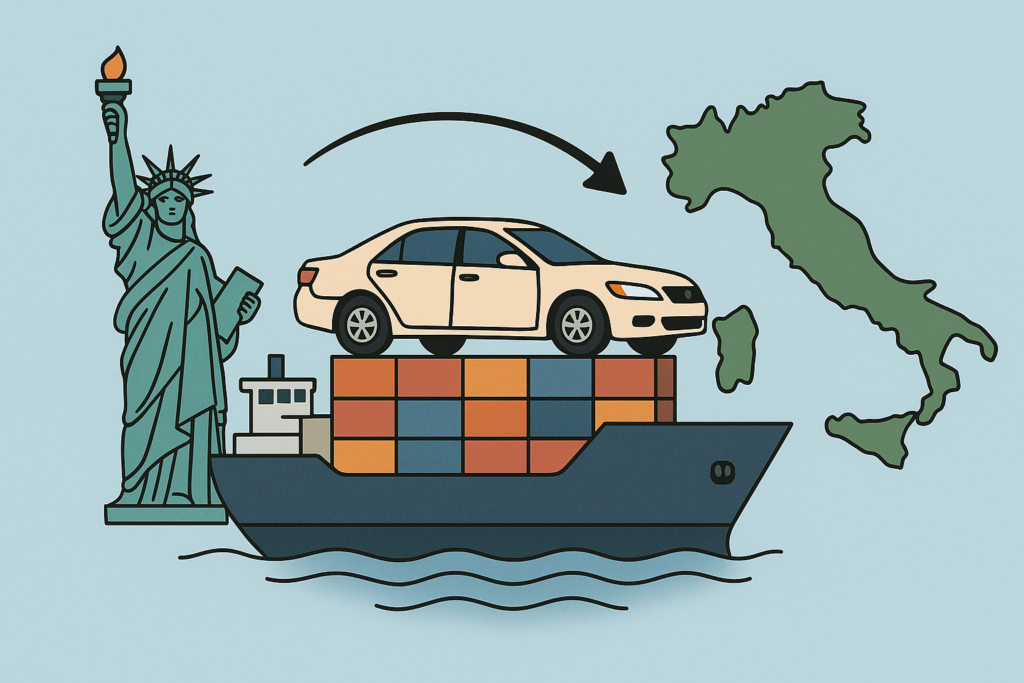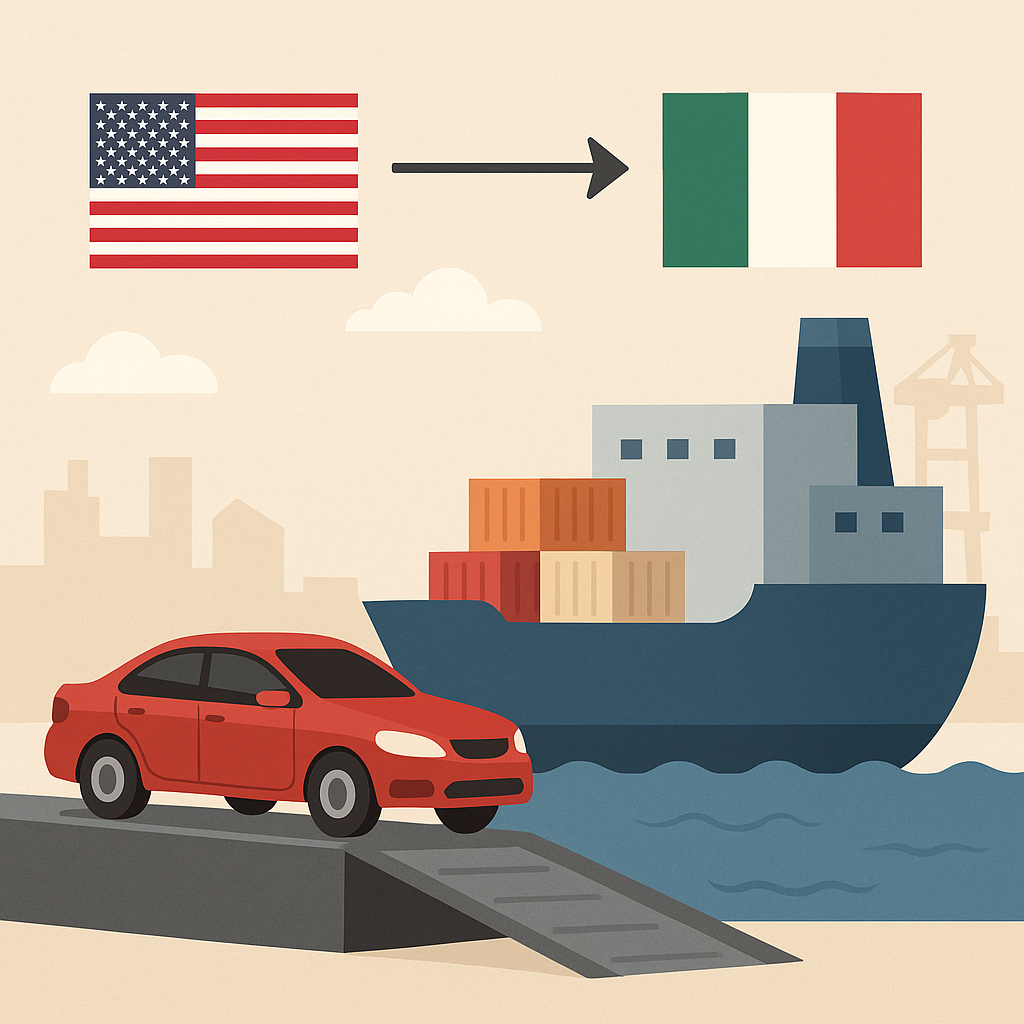Bringing your car to Italy from the United States can seem like a daunting process, but with the right preparation, it’s entirely doable and for many, it’s worth it. Whether you’re relocating permanently, transferring a classic car collection, or seeking the value advantage of U.S. auto prices, this guide breaks down every step of the journey, from shipping and documentation to taxes and car registration in Italy.
Table of Contents
ToggleChoosing the Right Shipping Method
One of the first decisions you’ll need to make is how to ship your vehicle across the Atlantic. There are two primary options: Roll-on/Roll-off (RoRo) and container shipping. RoRo is generally more affordable and ideal for operable vehicles that don’t need extra protection during the journey. Your car is simply driven onto the ship and secured below deck. However, this kind of method does not allow you to keep any personal belongings inside, and insurance is generally not allowed.
Container shipping is better protected but more expensive. It’s optimum for luxury cars, non-running cars, or goods with personal items. Shared container shipping allows you to share the cost with other cars, and a sole-use container gives you full timing and space management. Usual ports shipped from the U.S. are Baltimore, Miami, New York, and Los Angeles. Cars usually arrive through one of Italy’s key ports, such as Genoa, Livorno, or Palermo.
The shipping timeline varies based on departure and arrival ports. From the East Coast, you can expect transit times of around 25-30 days. From the West Coast, it might take closer to 35-40 days. High season demand and port congestion can affect these timeframes, so it’s best to begin planning at least 6-8 weeks in advance.

Required Documents and Preparation
Shipping a car internationally is more than just a logistics challenge, it’s a legal one. Italian customs are strict, and documentation must be complete and accurate. At minimum, you’ll need the vehicle’s original title (cleared of any liens), a bill of sale or invoice proving ownership, a copy of your passport, and a completed shipping form from your provider. In most cases, you’ll also need a Power of Attorney to allow your shipping agent to handle customs clearance on your behalf.
One of the most significant papers is the Certificate of Conformity (COC), which guarantees that the vehicle meets the European Union safety and environmental standards. The COC is issued by the manufacturer but, if not available, may be purchased through agencies or websites like EuroCOC. All the documents need to be translated into Italian by an authorized translator before being presented.
Additionally, your vehicle must be thoroughly cleaned especially the undercarriage to avoid transferring any foreign soil or biological material. This requirement is taken seriously in Italian ports and failure to comply can result in delays and fines.
Import Taxes and Italian Duties
Taxes and duties are included in the process, and Italy’s are high. The import duty will cost you 10% of the car’s customs value and an additional 22% Value Added Tax (IVA) on the shipping expense and value of the car. The tax is reported with the F24 form to the Italian tax authority, Agenzia delle Entrate.
There are exceptions, of course. If you’re a returning Italian citizen who’s been abroad for more than 18 months, or a foreigner immigrating to Italy, you’ll be eligible for some exemptions—if you can prove ownership of the car for at least 12 months prior to shipping. Vintage cars over 30 years old may also qualify for reduced VAT rates, even 7%, and can typically be exempt from import fees on top of that.
Car Registration in Italy
Once the car arrives and customs clear it, you cannot drive it yet. The next step is to register it locally, which is carried out by Italy’s Motor Vehicles Office (Motorizzazione Civile). You will have to submit all documents in translation form, customs clearance, and undergo a technical check if necessary.
After you’ve submitted your documents, the vehicle is entered on the Pubblico Registro Automobilistico (PRA), and you receive your Italian registration document and plates. Your vehicle is only legally allowed on Italian roads afterwards. On top of that, you need to pay the annual road tax (bollo), with varying fees depending on the region and the type of vehicle. Third-party liability insurance must also be taken before you can use your vehicle.
What Does It Cost?
Although actual prices depend on many factors such as the type of car, port of departure, and shipping mode, here’s what an average small car imported from the U.S. costs:
| Expense | Estimated Cost |
| RoRo Shipping (East Coast) | $1,200 |
| Import Duty (10%) | $2,000 (on $20,000 car) |
| VAT (22%) | $4,840 |
| Port and Customs Fees | $500–$1,000 |
| Translation and Registration | €500–€800 |
| Total Estimate | $8,500–$10,000 |
Keep in mind, these figures can vary greatly based on your departure city, chosen shipping company, and whether your vehicle qualifies for any exemptions.
Before You Import Your Car
Yet, before going ahead, make sure your American vehicle is conforming to European regulations. This can include changes in headlights, turn signals, emissions systems, and electronic displays. Repairs or changes to meet conformity can cost a lot and need to be factored into your budget.
You should also consider servicing in the long term. Certain U.S. models are not available to buy in Europe, and therefore parts and skilled mechanics are hard to come by. In large cities like Milan or Rome, it is not such an issue, but in small towns, it could be.
All things considered, most importers find that the value of their vehicle, together with the security and convenience of knowing a vehicle, is more than worth the bureaucratic hell. Having a specialist shipping firm or Italian “agenzia pratiche auto” (automobile paperwork agency) can make it faster, simpler, and a whole lot less agro.
🇺🇸➡️🇮🇹 Car Import Fee Calculator
Ready to Drive in Italy?
If you’re prepared, importing your car from the USA to Italy doesn’t have to be overwhelming. It’s a detailed process, but not an impossible one. Take the time to research your shipping provider, gather your documents in advance, and don’t underestimate the value of expert assistance.
Whether you’re importing your dream car or just wishing to make your transition into Italy homey, this guide puts you on the path to triumph in Italy.
Would you like to learn more about similar topics? Then, take a look at our related articles here, Living (and Paying Taxes) in Italy with a Green Card, Is American Express Accepted in Italy? and Buying a house in Italy: What to be careful about.




